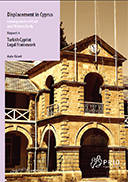After 1974, Turkish Cypriots had to deal with their displaced persons (some of whom had been displaced since 1963), build up a new social and economic environment in their new territory in the north, and generally put to proper economic use the immovable properties left behind by the Greek Cypriot inhabitants of the north who had nearly all fled to the south. Over the many years that have passed since 1974, Turkish Cypriots have put in place a whole body of complex legal measures. These reflect not only the peculiarities of the socio-economic circumstances but also the political and strategic anxieties of Turkish Cypriots connected with their ongoing conflict with Greek Cypriots. What makes these measures even more complex, of course, is the fact that they have created a property regime in the north which is in some respects highly incompatible with the one in the south and quite problematic with regard to international law.
It is clear that in any process of reconciliation and/or normalization of relations between the two communities, property issues will prove to be the most challenging area. The incongruity of the property regimes operating in the two parts of the island only adds to this challenge. A sound understanding of the nature of these regimes is therefore crucial in any effort to grasp the intricacies of the Cyprus problem. This report provides a concise summary of the Turkish Cypriot legal arrangements concerned with displaced persons and immovable properties, with a particular focus on those that have been motivated by conflict-related anxieties and/or political goals.
Also available in the following languages:








